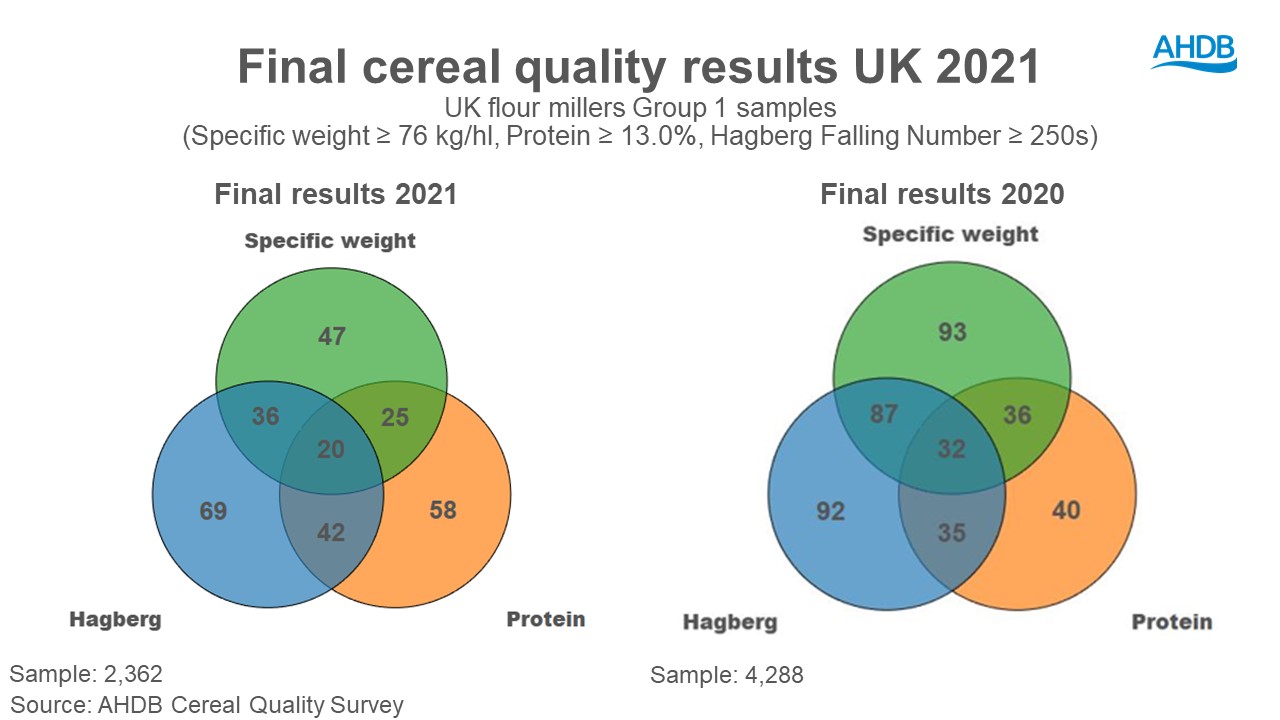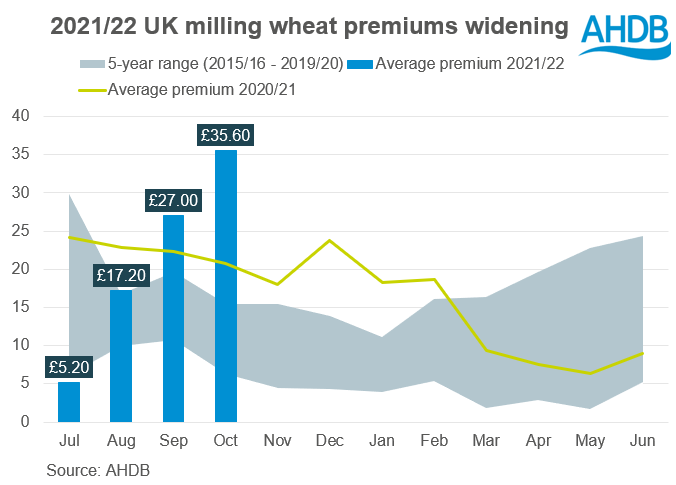- Location
- Stoneleigh
The final set of results are now available for the AHDB Cereal Quality Survey (CQS). Challenges look to remain in group 1 milling wheat especially, as we see premiums continue to grow.
The average specific weight of UK flour millers Group 1 varieties remains at 75.4kg/hl, the lowest since 2012 (70.7kg/hl). This sits below the milling specification of greater than or equal to 76.0kg/hl. These results are down 5 percentage points (pp) (4.0kg/hl) from 2020, and 4pp (3.1kg/hl) from the 3-year average (2018-2020).
Looking at other quality measures of group 1 wheats, Hagberg Falling Number remained at 286 seconds (s). This is 36s below 2020 results and 33s below the 3-year average. This is the lowest value since 2017. There is a clear difference between central (309s) and southern samples (263s) in Hagberg numbers, though this may be down to varietal breakdown within the regions.
For protein content, final figures show group 1 samples are averaging 13.2%. This is up 2.6pp (0.3%) from last year and above the 3-year average by 3.7pp (0.5%). Perhaps not surprising with specific weights down.
Overall, results show that 20% of group 1 samples are meeting a typical group 1 specification (specific weight≥76kg/hl, protein≥13.0%, HFN≥250s). This is down 3pp from provisional 2021 results and down 12pp from 2020.

With a reduced number of samples meeting a full milling specification, it is unsurprising premiums have continued to grow. Although there is also support from elsewhere as well. However, lower specific weights, may cause a drop in extraction rates. As a result, a higher volume of wheat could be needed to meet flour demand.

Final winter barley averages remained at 1.57%, the same as earlier results. Though we did see an increase to spring barley nitrogen, up 0.03% from initial results to 1.48%.
Lower nitrogen content is an area to watch for brewers, maltsters, and distillers (BMD). The latest BMD usage data released yesterday, showed barley usage year-to-date (Jul-Sept) was down 5pp compared to the pre-covid 3-year average (2017/18-2019/20).
Specific weights are down versus initial results, and lower year-on-year, for both winter barley (at 64.8kg/hl) and spring barley (at 63.0kg/hl).
The proportion of barley retained by a 2.5mm sieve, compared to initial 2021 results, increased clearly for winter barley (up 2.5% to 87.8%) and marginally for spring barley (up 0.1% to 95.4%). Yet, winter results remain down 7pp year-on-year. Spring results are in line with last harvest.
Interesting to note, sales of barley and screenings for 2021/22 season-to-date (Jul-Sept) are down by 6pp compared to the pre-covid 3-year average for the same period (2017/18-2019/20).
Note
This year’s wheat sample is down year-on-year from final 2020 results. We have been hearing sampling has been difficult this year, due to labour availability. The barley sample size if relatively consistent year-on-year.
Final survey results show milling wheat quality challenges continue
For information on price direction make sure to subscribe to Grain Market Daily and Market Report from our team.
Wheat samples persist with low specific weights
Final quality results from harvest 2021, capturing data to 26 October, show milling wheat samples continue to display low specific weights.The average specific weight of UK flour millers Group 1 varieties remains at 75.4kg/hl, the lowest since 2012 (70.7kg/hl). This sits below the milling specification of greater than or equal to 76.0kg/hl. These results are down 5 percentage points (pp) (4.0kg/hl) from 2020, and 4pp (3.1kg/hl) from the 3-year average (2018-2020).
Looking at other quality measures of group 1 wheats, Hagberg Falling Number remained at 286 seconds (s). This is 36s below 2020 results and 33s below the 3-year average. This is the lowest value since 2017. There is a clear difference between central (309s) and southern samples (263s) in Hagberg numbers, though this may be down to varietal breakdown within the regions.
For protein content, final figures show group 1 samples are averaging 13.2%. This is up 2.6pp (0.3%) from last year and above the 3-year average by 3.7pp (0.5%). Perhaps not surprising with specific weights down.
Overall, results show that 20% of group 1 samples are meeting a typical group 1 specification (specific weight≥76kg/hl, protein≥13.0%, HFN≥250s). This is down 3pp from provisional 2021 results and down 12pp from 2020.

With a reduced number of samples meeting a full milling specification, it is unsurprising premiums have continued to grow. Although there is also support from elsewhere as well. However, lower specific weights, may cause a drop in extraction rates. As a result, a higher volume of wheat could be needed to meet flour demand.

Barley nitrogen content remains lower year-on-year
Using data up to the 25 October, results show average GB nitrogen content is 1.49%. This is the lowest GB value in AHDB’s historic data, back to 1977. The closest comparative year is 2015, at 1.52%. Though to note, a higher volume of Scottish samples has been included in the survey this year compared to last year. Scottish nitrogen content remains comparatively lower than English values due to requirements from distilling markets in Scotland.Final winter barley averages remained at 1.57%, the same as earlier results. Though we did see an increase to spring barley nitrogen, up 0.03% from initial results to 1.48%.
Lower nitrogen content is an area to watch for brewers, maltsters, and distillers (BMD). The latest BMD usage data released yesterday, showed barley usage year-to-date (Jul-Sept) was down 5pp compared to the pre-covid 3-year average (2017/18-2019/20).
Specific weights are down versus initial results, and lower year-on-year, for both winter barley (at 64.8kg/hl) and spring barley (at 63.0kg/hl).
The proportion of barley retained by a 2.5mm sieve, compared to initial 2021 results, increased clearly for winter barley (up 2.5% to 87.8%) and marginally for spring barley (up 0.1% to 95.4%). Yet, winter results remain down 7pp year-on-year. Spring results are in line with last harvest.
Interesting to note, sales of barley and screenings for 2021/22 season-to-date (Jul-Sept) are down by 6pp compared to the pre-covid 3-year average for the same period (2017/18-2019/20).
Note
This year’s wheat sample is down year-on-year from final 2020 results. We have been hearing sampling has been difficult this year, due to labour availability. The barley sample size if relatively consistent year-on-year.
Final survey results show milling wheat quality challenges continue
For information on price direction make sure to subscribe to Grain Market Daily and Market Report from our team.





